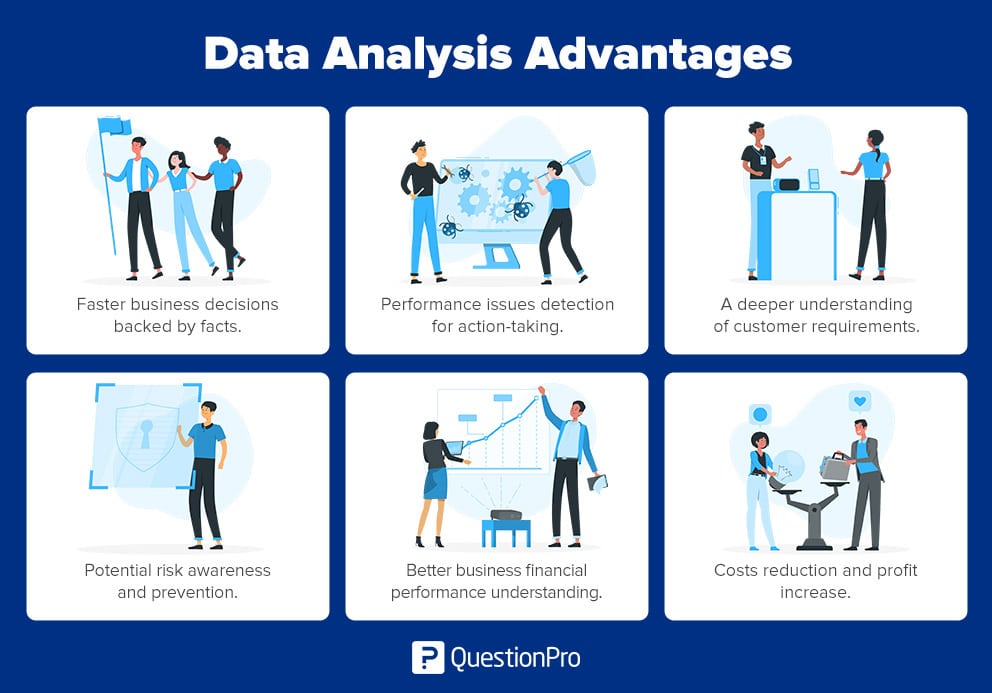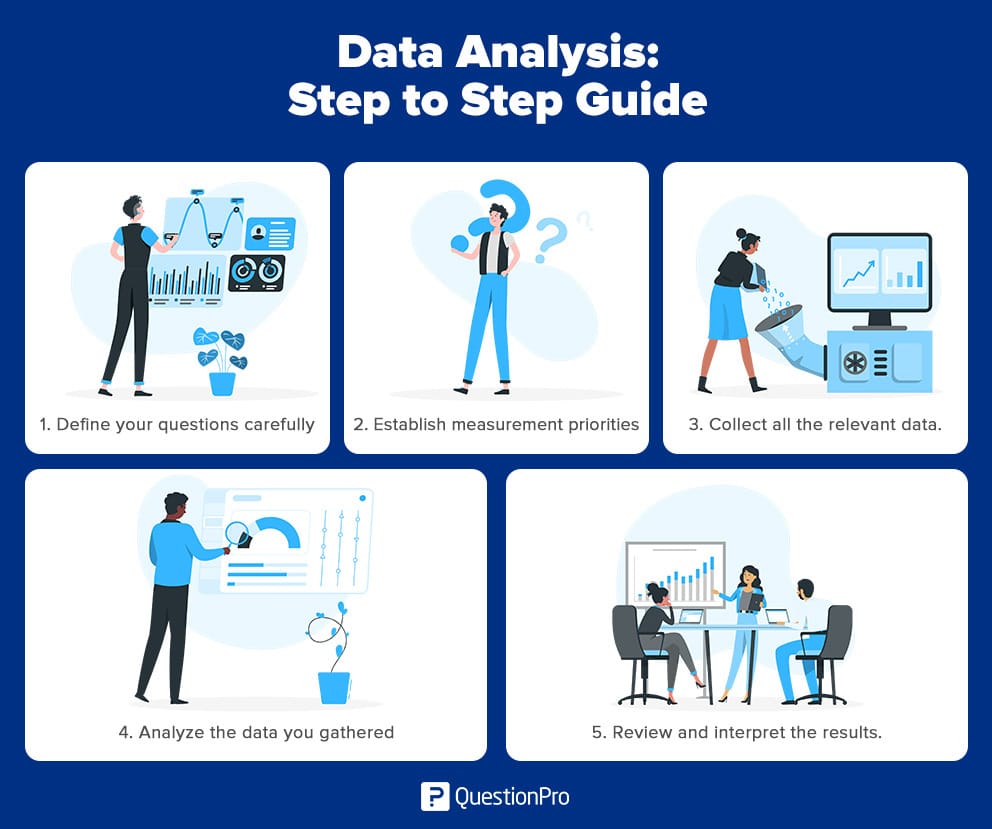Which Of The Following Activities Are Examples Of Data Organization And Analysis?
To this mean solar day, we collect data at various points of processes and transactions, which has cracking potential to change the way we work for the meliorate. All the same, this information assay tin only add value to the business when analyzed to gain insights into improving your products and services. It allows you to know and interpret information to place value points. But wchapeau is data analysis in simple words?
What is data analysis?
Information analysis is the science of examining information to conclude the information to make decisions or expand knowledge on various subjects. Information technology consists of subjecting information to operations. This procedure happens to obtain precise conclusions to help us achieve our goals, such as operations that cannot be previously defined since data collection may reveal specific difficulties.
"A lot of this [data analysis] will help humans work smarter and faster because we have data on everything that happens". – Daniel Burrus, business consultant and speaker on business and innovation issues.
Data analysis Advantages
Currently, many industries utilise information to describe conclusions and decide on actions to implement. Information technology is worth mentioning that scientific discipline too uses data analysis to examination or discard existing theories or models.
At that place's more one reward to data analysis done right. Here are some examples:

- Make faster and more than informed business organisation decisions backed by facts.
- Place functioning bug that require action.
- Gain a deeper understanding of customer requirements, which creates better business organization relationships.
- Increase awareness of risks to implement preventive measures.
- Visualize dissimilar dimensions of the data.
- Proceeds competitive advantage.
- Ameliorate understand the financial functioning of the business.
- Identify ways to reduce costs and thus increase profits.
These questions are examples of different types of data analysis. You can include them in your mail service-event surveys aimed at your customers:
- Qualitative research analysis focuses on opinions, attitudes, and behavior.
- Questions start with: Why? How?
Example of qualitative data assay: Panels where a discussion is held, and consumers are interviewed near what they similar or dislike about the place.
- Quantitative research assay focuses on circuitous data and data that tin be counted.
- Data is collected by asking questions like: How many? Who? How ofttimes? Where?
Instance of quantitative data analysis: Surveys focused on measuring sales, trends, reports, or perceptions.
Uses of data analysis
It is used in many industries regardless of the branch. It gives us the basis to brand decisions or confirm if a hypothesis is true.
- Marketing: Mainly, researchers perform data analysis to predict consumer behavior and assistance companies place their products and services in the market accordingly. For instance, sales data assay can help you identify the production range not-so-pop in a specific demographic group. It tin can give you insights into tweaking your current marketing entrada to better connect with the target audience and address their needs.
- Human Resources: Organizations tin can utilize data analysis to offering a great experience to their employees and ensure an excellent work environment. They tin also use the data to notice out the best resources whose skill fix matches the organizational goals.
- Academics: Universities and academic institutions can perform data analysis to measure pupil functioning and gather insights on how certain behaviors tin further improve education.
Techniques for Analysis
It is essential to analyze raw information to understand it. We must resort to various techniques that depend on the type of information collected, so it is crucial to define the method earlier implementing it.
- Qualitative data analysis: Researchers collect qualitative data from the underlying emotions, body language, and expressions. Its foundation is the estimation of exact responses. The most common ways of obtaining this information are through open-concluded interviews, focus groups, and observation groups, where researchers generally analyze patterns in observations throughout the data collection phase.
- Quantitative data analysis: Quantitative data presents itself in numerical grade. It focuses on tangible results.
Data assay focuses on reaching a decision based solely on the researcher'southward current knowledge. How y'all collect your data should relate to how you plan to analyze and apply it. You too demand to collect accurate and trustworthy information.
There are many data drove techniques, merely experts' most normally used method is online surveys. It offers significant benefits such as reducing time and coin compared to traditional data collection methods. The
At QuestionPro, we have an authentic data assay tool that will assistance you professionally make better decisions.
Steps to Step Data Analysis Guide
With these five steps in your data analysis process, you will make better decisions for your business considering data that has been well collected and analyzed support your choices.

Footstep 1: Ascertain your questions
Offset by selecting the right questions. Questions should exist measurable, clear, and curtailed. Design your questions to qualify or disqualify possible solutions to your specific trouble.
Step 2: Establish measurement priorities
This footstep divides into two sub-steps:
- Decide what to measure: Clarify what kind of data yous need.
- Decide how to measure it: Thinking about how to mensurate your data is just as important, especially earlier the data drove phase, because your measurement process supports or discredits your analysis after.
Step three: Collect data
With the question clearly defined and your measurement priorities established, at present it's time to collect your data. Every bit you lot manage and organize your data, remember to go on these essential points in mind:
- Before collecting new data, determine what information you could gather from existing databases or sources.
- Make up one's mind a storage and file naming system to assistance all team members collaborate in advance. This process saves time and prevents team members from collecting the same information twice.
- If you need to collect data through surveys, ascertainment, or interviews, develop a questionnaire in advance to ensure consistency and save time.
- Keep the collected data organized with a log of collection dates, and add any source notes equally yous go along.
Step four: Analyze the data
One time y'all've nerveless the correct data to answer your Step 1 question, it'south time to comport a deeper analysis. Detect relationships, identify trends, sort and filter your data according to variables. As you clarify the data, you volition find the exact information you demand.
Footstep 5: Interpret the results
After analyzing the information and possibly conducting further inquiry, information technology is finally fourth dimension to interpret the results. Inquire yourself these key questions:
- Does the data answer your original question? How?
- Does the data help you defend whatsoever objections? How?
- Are there whatever limitations to the conclusions, any angles you oasis't considered?
If the interpretation of data holds up under these questions and considerations, you have reached a productive conclusion. The merely remaining step is to use the results of the information analysis process to determine how you are going to human activity.
Bring together u.s.a. every bit we wait into the near ofttimes used question types, and how to effectively clarify your findings.
Make the right decisions by analyzing data the correct way!
With QuestionPro, you can generate reports in existent-time, start a free trial of our survey software, or schedule a demo of our powerful tool. Nosotros are here to aid yous.
Create a Gratuitous Business relationship
Which Of The Following Activities Are Examples Of Data Organization And Analysis?,
Source: https://www.questionpro.com/blog/what-is-data-analysis/
Posted by: danielswhimmight77.blogspot.com


0 Response to "Which Of The Following Activities Are Examples Of Data Organization And Analysis?"
Post a Comment